Mastering the Google Analytics 4 Transition: A Comprehensive Guide
As Google leaps into its latest tracking property, Google Analytics 4 (GA4), marketers worldwide are bracing for a significant shift away from traditional attribution models. Come July 2023, GA4 will be the only data collection option within Google Analytics, marking a new age in tracking and measurement.
This transition is underscored by Google's decisive move away from four key attribution models - first click, linear, time decay, and position-based - towards the Data-Driven Attribution (DDA) model while keeping the last click attribution model. At first, this shift seems to aim to improve transparency and conversion tracking, but it also poses a new set of challenges that marketers must tackle head-on.
In this comprehensive guide, we aim to:
- Delve deeply into the complexities of GA4, offering a clearer understanding of Google's latest tracking platform.
- Examine the potential consequences of Google's move from traditional attribution models to the DDA model.
- Highlight the challenges that marketers may face due to the removal of the traditional attribution models.
- Investigate the rising demand for alternative measurement solutions and third-party vendors in the wake of this considerable adjustment.
- Include an exploration of Adtriba to help facilitate smoother use of GA4.
As we delve into the intricate world of GA4, we're excited to share that we've prepared a special offer to assist you in this transition. Be sure to read on to discover more, or look out for the details towards the end of this guide.
Exploring GA4: What Marketers Need to Know
GA4 isn't just another update from Google – it's a substantial shift in how we approach tracking and attribution models. This move raises some important questions: What exactly is GA4? Why has Google introduced it, and what's its rationale? And perhaps most pressingly, how does this affect marketers, many of whom have expressed concerns about the transition? Let's demystify GA4 and shed light on these issues, bringing clarity to your performance marketing strategy in the process.
Understanding GA4
Google Analytics 4 (GA4) is Google's latest iteration of its widely-used analytics platform. Significantly different from its predecessor, Universal Analytics (UA), GA4 introduces new features and functions that aim to provide a more comprehensive picture of user behavior across web and app-based platforms. However, it's important to note that this new model comes with its own set of challenges and limitations, which marketers should understand for a well-rounded view of their analytics.
One of the core features of GA4 is its focus on an event-driven data model. Unlike the session-based model of UA, GA4 is said to be designed to track specific user actions, such as button clicks or page scrolls, across both websites and mobile applications. This allows for a more granular understanding of how users interact with a digital platform, which can potentially offer more nuanced insights into user behavior.
The main standout advantage of GA4 is its access to user-level tracking at no cost. This means that marketers can delve deeper into understanding individual user behavior and interactions within their website or app without incurring additional expenses.
The DDA model uses machine learning to determine how much credit to assign to each touchpoint in the customer journey. However, this raises questions about transparency, trustworthiness, and the potential for bias in attribution, given the lack of visibility into how the GA4 DDA model makes these determinations.
Perhaps the most crucial change in GA4 regarding marketing analytics is its shift from traditional attribution models—first click, linear, time decay, and position-based—to DDA. While GA4 retains the last-click attribution method, which assigns all credit for a conversion to the final touchpoint, this method is widely recognized as suboptimal. It neglects the influence of previous touchpoints that may have played a crucial role in driving the conversion. So, why exactly is Google making the switch to GA4?
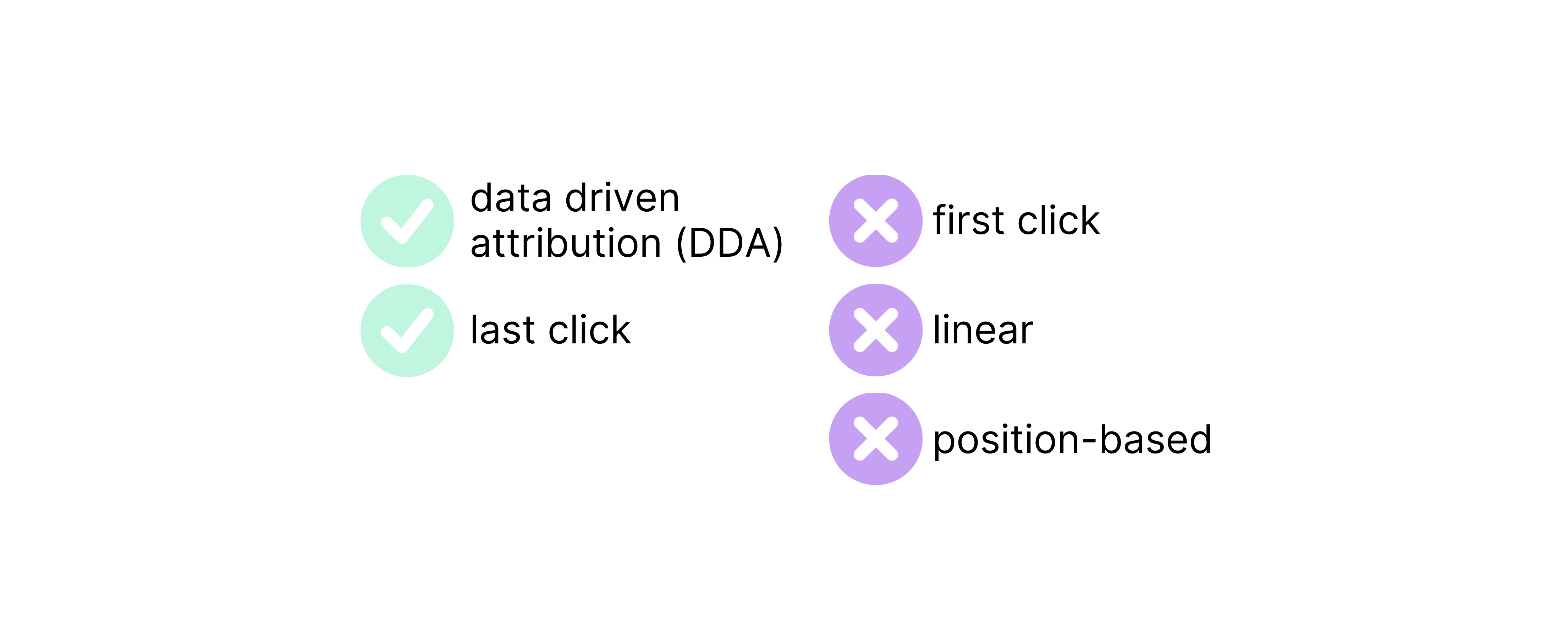
Why is Google Switching to GA4?
Google's decision to shift from traditional attribution models to DDA in GA4 represents a significant change in its approach to tracking and attributing conversions. But why has Google chosen to make this move?
According to Ginny Marvin, Google Ads liaison, the upcoming change in attribution models is a part of Google's effort to simplify measurement processes. As identified by Google, the traditional attribution models being phased out include first click, linear, time decay, and the less frequently used position-based models.
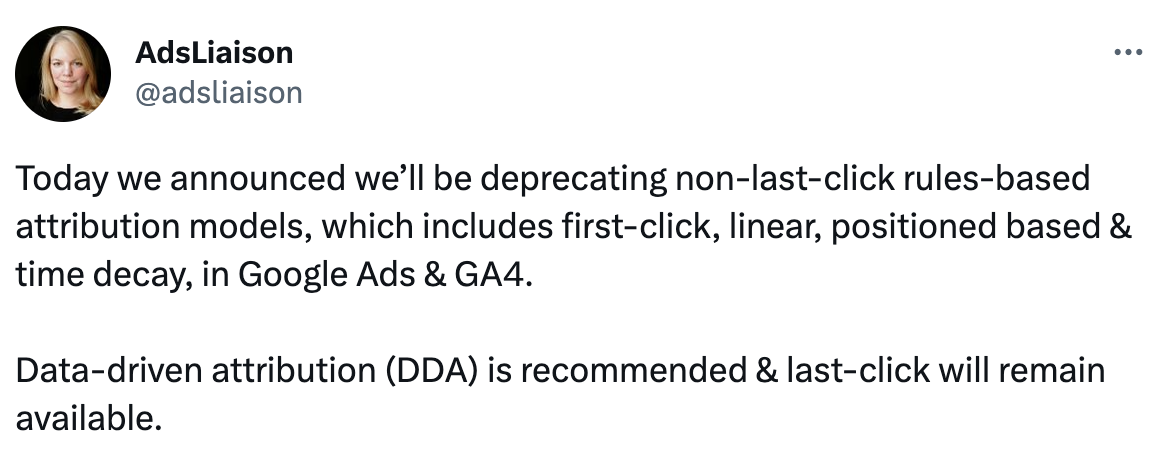 However, this shift in models was met with mixed reactions from marketers. Many expressed concerns over the transparency of the DDA model and the potential bias towards Google's channels. These concerns raise important questions and challenges for marketers seeking to adapt to the new analytics landscape. These issues, among others, will be further explored in the following sections.
However, this shift in models was met with mixed reactions from marketers. Many expressed concerns over the transparency of the DDA model and the potential bias towards Google's channels. These concerns raise important questions and challenges for marketers seeking to adapt to the new analytics landscape. These issues, among others, will be further explored in the following sections.
Key Takeaways
- GA4 introduces a new event-driven data model, tracking specific user actions across web and app platforms for more detailed insights into user behavior.
- GA4 represents a significant shift from traditional attribution models—first click, linear, time decay, and position-based—to a Data-Driven Attribution (DDA) model.
- The DDA model employs machine learning to determine credit for each touchpoint in the customer journey, a change that raises questions about transparency and potential bias in attribution.
- The shift to DDA is part of Google's effort to simplify measurement processes and phase out less frequently used models. However, this change has elicited mixed reactions from marketers due to potential bias toward Google's channels.
Timeline for the Phase-Out of Google's Attribution Models
So, when can marketers expect this significant shift to take place? Below, we outline the phase-out timeline for Google's existing attribution models.
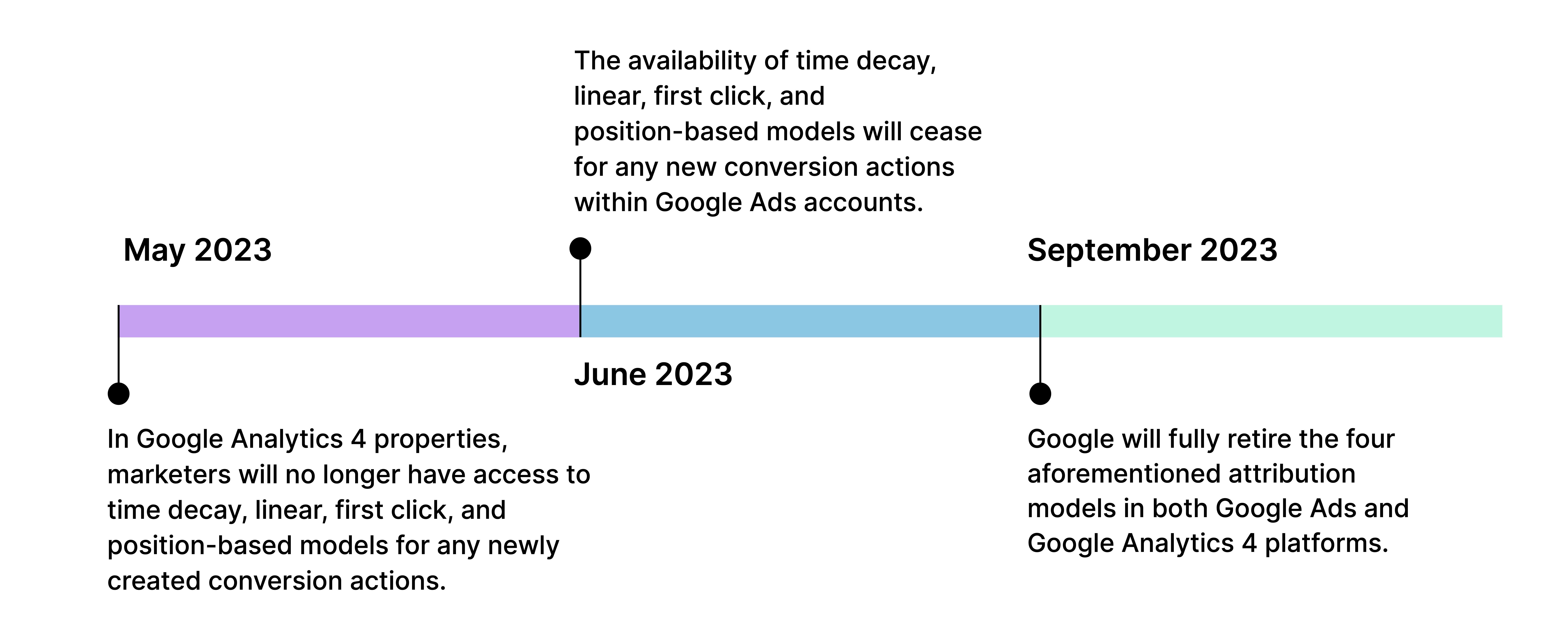
Challenges of GA4 for Marketers
Marketers may be torn between whether or not they feel this change will be useful. Let’s look at just how marketers will be impacted by this shift in attribution models.
1. Transparency Issues in Data Tracking
One of the primary concerns raised by marketers about GA4's new approach is the issue of transparency. While Google claims that its Data-Driven Attribution model, powered by machine learning algorithms, provides a more accurate representation of customer journeys, the exact details of how this model works remain undisclosed.
Marketers are essentially asked to trust Google's black box attribution algorithms without understanding the specifics of how the data is processed and interpreted. This lack of transparency can make it difficult for marketers to fully trust the results they are seeing and validate the insights they are gleaning from GA4. On the flip side, Adtriba provides full transparency and accessibility to all attribution algorithms. This means users have a clear insight into the machine learning processes and a deep understanding of how the data they see is generated.
2. Potential Bias Towards Google's Own ChannelsA critical consideration for marketers is the potential bias in GA4's evaluation of marketing performance. As the largest ad platform, Google's analytics solution might not provide an entirely unbiased and independent perspective. Savvy advertisers today prefer not to rely solely on the data provided by ad platforms themselves.
To mitigate this issue, marketers are increasingly turning to independent third-party attribution tools, such as Adtriba. Our tool offers a more objective assessment of marketing performance, ensuring that advertisers make well-informed decisions based on accurate data, rather than relying on potentially biased information from the ad platforms they are investing in.
3. Overlooking Broader Influences on Customer Behavior
GA4's event-driven data model falls short in considering broader influences on customer behavior which is key to comprehensive marketing strategies. Marketing Mix Modeling (MMM) captures both online and offline marketing activities, seasonal trends, and competitive actions, providing a holistic view of marketing effectiveness.
However, GA4 primarily focuses on individual online user actions, potentially overlooking offline marketing activities and broader market trends. For example, a significant shortcoming of GA4 is its inability to effectively measure the impact of television advertisements or TV attribution. This blind spot in GA4 means that marketers may struggle to understand the conversion rates of their TV ads, how these ads contribute to multi-channel campaigns, or how the medium interacts with other marketing channels.
Adtriba broadens the scope of attribution by incorporating offline marketing activities and macro-market factors, providing a more comprehensive understanding of customer behavior.
4. Streamlining Cost Data Integration
For marketers, a comprehensive understanding of marketing performance necessitates integrating cost data across all channels. However, this task presents a significant challenge when using GA4 alone.
Why is this significant? Without a complete picture of your marketing costs across all platforms—from PPC advertising to social media campaigns and email marketing—you could be left with an incomplete understanding of your total marketing investment and, consequently, an unclear view of your ROAS.
Adtriba facilitates the integration of cost data across all channels, allowing marketers to consolidate information and gain a clearer understanding of overall marketing investment and returns.
5. The Shortcoming of Display View Attribution in GA4
A key consideration when evaluating the effectiveness of display advertisements is not just the number of clicks on the display banners but also the number of impressions, or views. However, GA4 falls short in this area as it does not support tracking and attributing display views for any marketing channels.
However, Adtriba comes to the rescue by providing a solution to this challenge. Adtriba recognizes the importance of display impressions and enables advertisers to easily integrate display views into their marketing attribution. By incorporating data from various display view channels, Adtriba empowers marketers with a more comprehensive understanding of their display advertisement performance. This functionality ensures that marketers can accurately evaluate the impact of their display campaigns and make informed decisions based on a holistic view of their marketing efforts.
6. Google Ads Bidding Optimization
The transition to GA4's attribution model poses significant challenges for marketers, especially concerning bidding optimization within Google Ads. Depending solely on the last click and Google’s own, intransparent data-driven attribution models for bidding optimization can yield biased results and hinder the accuracy of campaign performance evaluation.
One of the limitations of GA4 is its exclusion of offline activities from the attribution process. Additionally, GA4 does not account for display or social ad views as part of the attribution methodology. These limitations create a potential bias towards Google Ads in the attribution results, potentially distorting the marketer's understanding of the actual influence of different touchpoints throughout the customer journey. This can lead to overspending on Google Ads and under-spending on upper-funnel Display or Social Ad campaigns.
Adtriba helps with its transparent and unbiased data-driven attribution modeling as well as the weighting and export of Google Click IDs (GClids) into Google Ads. It also incorporates aggregated views for display and social ads and offline marketing activities through UMM. This way, Adtriba ensures that the impact of GClids is not overestimated and prevents overspending on Google Ads.
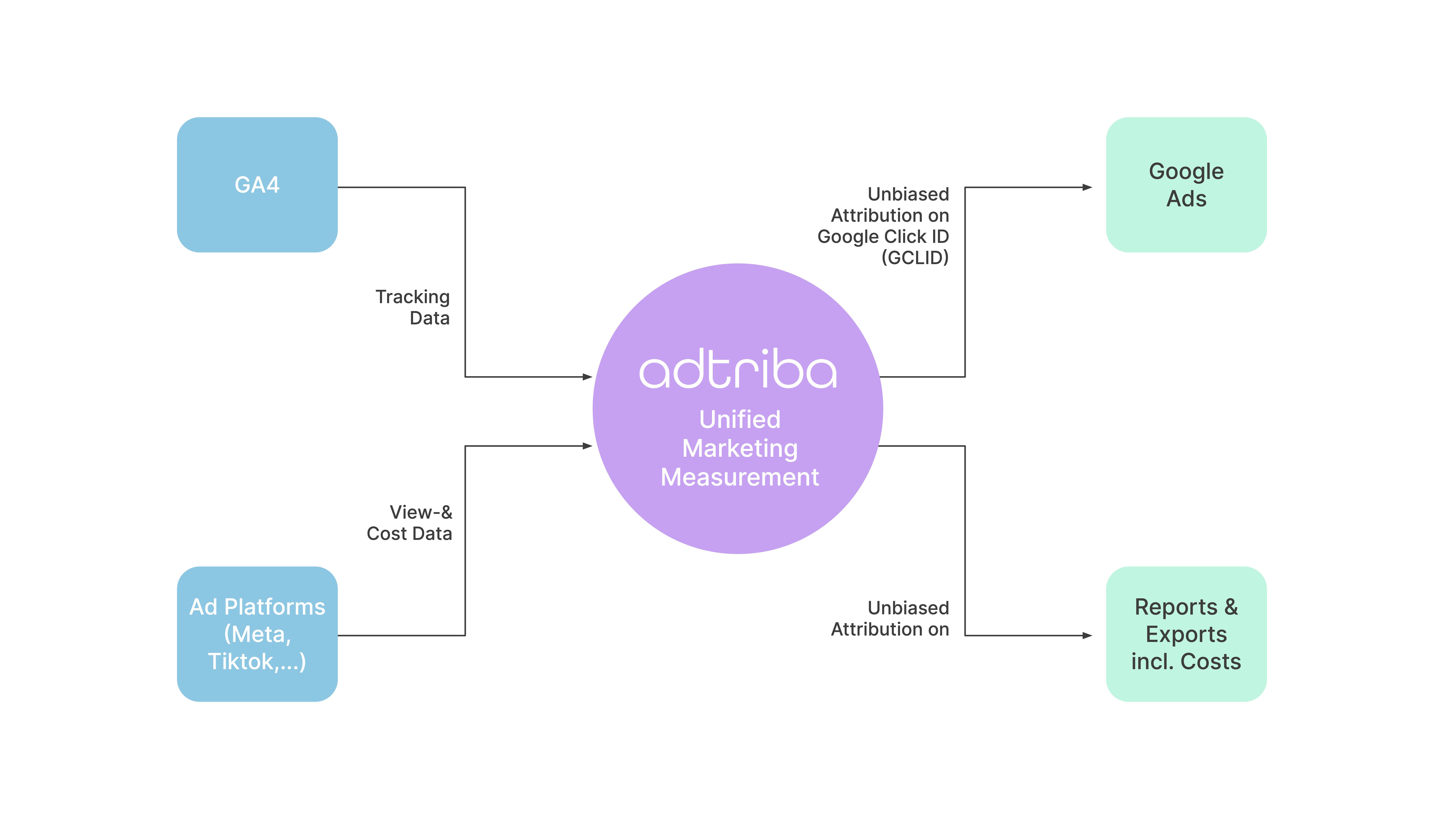
How Adtriba Helps Overcome GA4's Attribution Challenges
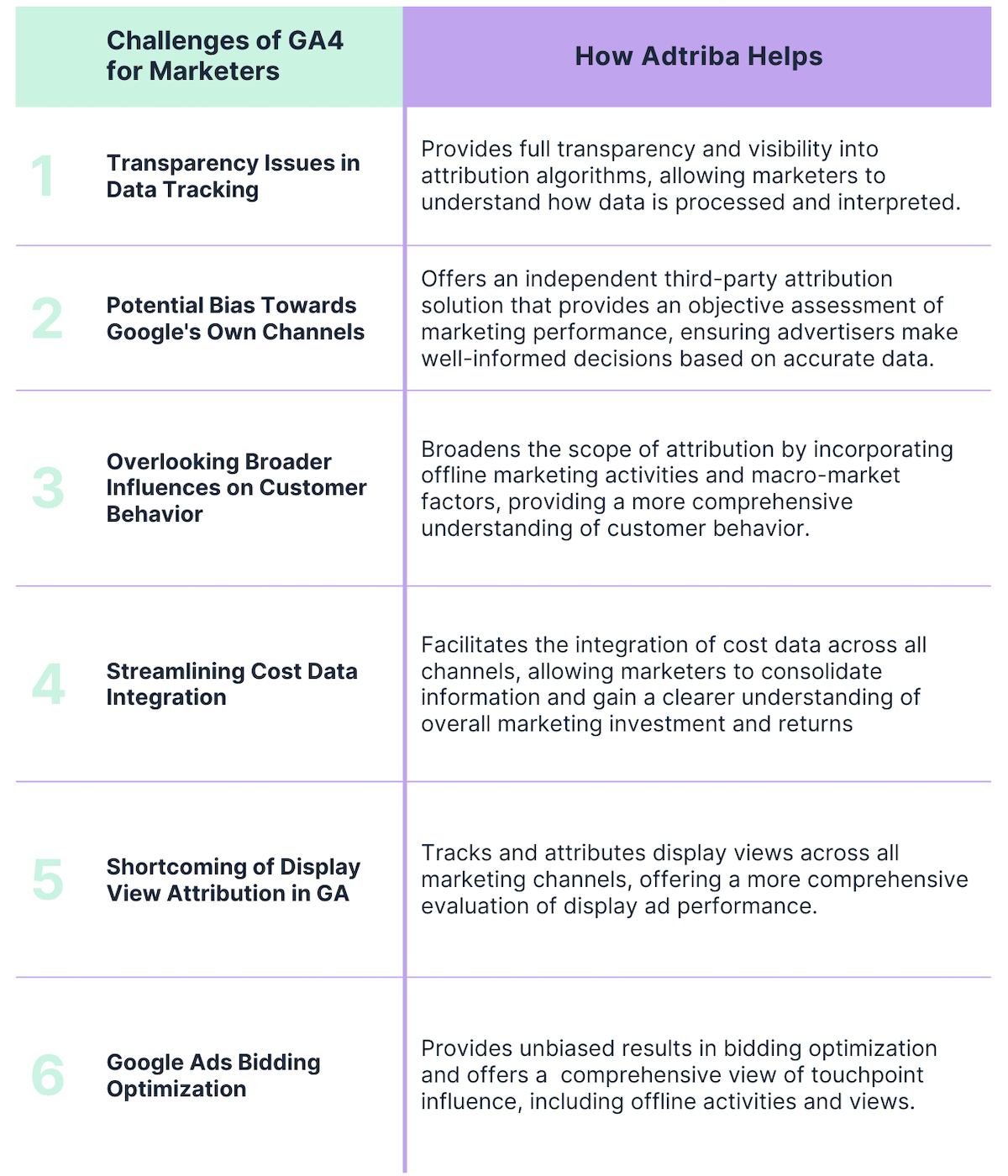
Key Takeaways
- GA4's Data-Driven Attribution model faces transparency issues due to its undisclosed algorithms.
- Potential bias towards Google's channels in GA4's evaluations may lead to inaccurate metrics.
- GA4 may overlook broader influences on customer behavior, such as offline marketing activities and market trends.
- Integrating cost data from all channels in GA4 can be challenging, obscuring clear insight into marketing investments and returns.
- GA4 does not support TV attribution, creating a significant gap for marketers using TV advertising.
- GA4 lacks support for tracking and attributing display views, limiting comprehensive evaluation of display ad performance.
The Role of Adtriba in GA4 Data Analysis
As the landscape of digital marketing evolves, so too must the tools and methodologies we use to navigate it.
Adtriba Core, our Unified Marketing Measurement (UMM) solution, is designed to complement GA4, enhancing its capabilities while addressing its limitations. This ensures that marketers have a more holistic understanding of their marketing performance, even as they adapt to the new tracking and attribution approach.
Adtriba applies a data-driven, fractional attribution model, providing a more nuanced perspective of the customer journey compared to GA4's Data-Driven Attribution model. By assigning credit to each touchpoint based on its impact on conversion, Adtriba offers a more balanced view of channel effectiveness by also including views across all channels. This not only fills in the gaps left by GA4 but also provides a clearer understanding of each touchpoint's role in the conversion path.
For example, consider a customer who sees your brand through an organic Instagram post, but does not click through to your website. Later, they interact with a sponsored post on Facebook but they do not convert yet. Then, they finally covert but only after first reading a blog and scrolling through customer reviews.
You may be wondering, how does UMM blend various data and insights effectively? At the heart of UMM lies a relationship between marketing mix modeling (MMM) and multi-touch attribution (MTA).
Firstly, MMM uses aggregated data, collating information from various online and offline sources, to provide a comprehensive view of marketing outcomes. It collects data from diverse elements like TV campaigns, paid searches, print advertisements, direct mail, and social media interactions. For instance, it can show that your recent billboard campaign led to a 20% increase in your direct website traffic.
Now, MTA steps in for a closer look by using user-level data. This method studies the journey of individual customers, tracking how each interaction or 'touchpoint' influenced their decision to buy. For example, MTA can reveal that a specific direct website visit—triggered by seeing your billboard—was responsible for 40% of a customer's decision to purchase.
UMM merges these insights by calculating the total impact of the billboard on sales by multiplying the MMM factor (20%) by the MTA weight (40%). This gives us 0.2 (MMM) multiplied by 0.4 (MTA) = 0.08 or 8%.
So, the total impact of the billboard ad, in this case, is 8%. This insight helps you understand exactly how effective that billboard campaign was in driving sales.
The Future of Marketing Measurement
As the digital marketing landscape undergoes substantial shifts, the future of marketing measurement lies in adaptability and innovation. With Google's Universal Analytics (UA) set to be sunsetted in the coming months, the transition to GA4 is no longer a matter of 'if,' but 'when.'
GA4, with its event-driven data model allowing for user-level tracking data, introduces a new level of granularity and understanding in tracking user interactions. However, it's vital to acknowledge that while GA4 is a significant step forward, it isn't a stand-alone solution. It may be beneficial in tracking digital touchpoints and rudimentary website analytics but falls short when it comes to providing a comprehensive view of the customer journey.
This is where integrating GA4 with Adtriba becomes not just beneficial, but essential for the future of marketing measurement. Adtriba's UMM solution enhances GA4's capabilities, filling in the gaps that were always there and the new ones, left by its shift to DDA. With Adtriba's fractional attribution model, marketers gain a more detailed understanding of each touchpoint's impact, leading to more effective marketing decisions.
As the clock ticks, marketers need to act swiftly to adapt to these changes and prepare for the future of marketing measurement. To support this transition, we are offering a special promotion for early adopters of Adtriba Core. For a limited time, new users can enjoy two free months of Adtriba!
This offer enables you to fully explore and leverage Adtriba's powerful capabilities, ensuring a seamless transition to GA4 and providing a more holistic view of your marketing performance.
To learn more about how using Adtriba alongside GA4 can aid your marketing efforts and to take advantage of this special offer, book a demo of Adtriba Core today.